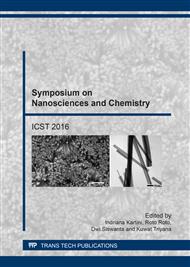p.3
p.8
p.14
p.20
p.26
p.32
p.37
p.44
Optimization of Chitosan/PVA Concentration in Fabricating Nanofibers Membrane and its Prospect as Air Filtration
Abstract:
Chitosan/polyvinyl-alcohol (Chitosan/PVA) based nanofibers were successfully produced using electrospinning machine and investigated their application as air filtration. Firstly, 2 wt% chitosan was dissolved to 1 wt% acetic acid followed by mixing with PVA solution to produce fiber mats or membrane. Secondly, the morphology and diameter of the electrospun fiber were analyzed by using a scanning electron microscopy (SEM), while the chemical compounds in the membrane were characterized using Fourier transform infrared spectroscopy (FTIR). It was found that the conductivity of solution increased by the concentration of chitosan. Meanwhile, the average diameter and percentage of porosity decreased due to the upsurge of the conductivity of the solution. The average diameter of PVA 13 wt% was and the percentage of porosity were 50.32%. The maximum condition of chitosan/PVA was obtained at 20/80 wt%, in line with the average of fiber diameters and the percentage of porosity were 25.32%. Physicochemical properties of chitosan/PVA solution, such as conductivity, morphology, and chemical absorption were investigated before and after the air filtration. The porosity percentage of PVA 13wt% after air filtration changed to 35.85% and the percentage of porosity of chitosan/PVA 20/80 became 25.32%. Remarkable absorption peaks of PVA 13wt% exhibited and - shifted after the air filtration test, it was indicating that functional groups had been reduced. The chemical absorption of chitosan/PVA 20/80 wt% showed at the the region then disappeared after the air filtration test.
Info:
Periodical:
Pages:
20-25
Citation:
Online since:
July 2017
Keywords:
Price:
Сopyright:
© 2017 Trans Tech Publications Ltd. All Rights Reserved
Share:
Citation:



